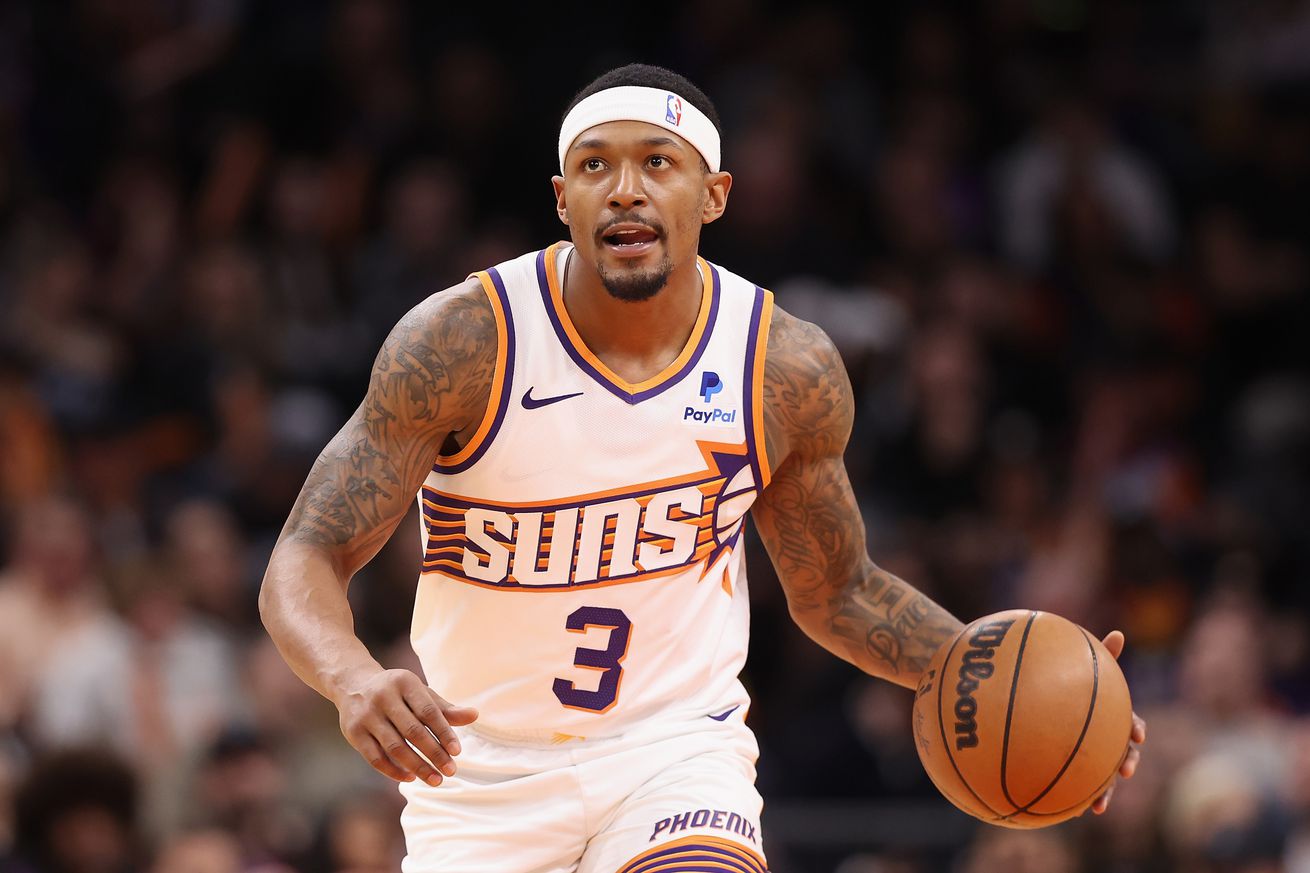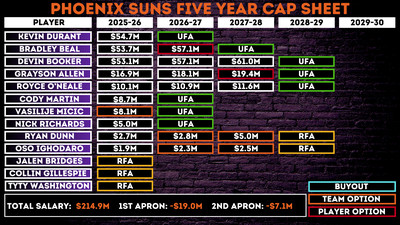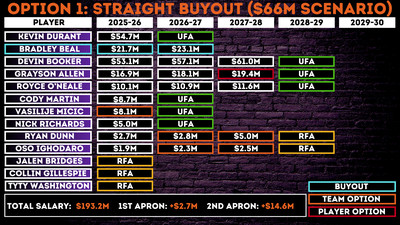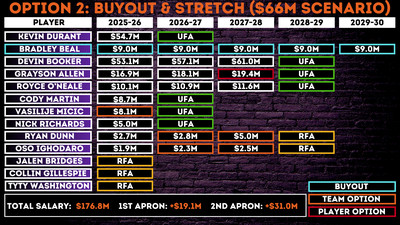
How would it work? Let’s break it down.
I’ve been turning this over in my head for weeks now, trying to land on a clear, cohesive thesis for how the Phoenix Suns should navigate the coming offseason. The options aren’t plentiful, but they exist.
Somewhere in an office filled with trade possibilities, cap sheets, and whiteboards scribbled with scenarios, new Suns’ general manager Brian Gregory is undoubtedly doing the same thing. He’s sifting through the narrow pathways available, mapping out what can be done within the suffocating constraints of the first and second apron restrictions, weighing mid-level exceptions, buyouts, stretch provisions, and the rapidly tightening trade market.
And looming over it all is one pivotal decision: what to do with Bradley Beal.
His no-trade clause remains a towering obstacle, limiting flexibility and leverage, but if a mutual understanding can be reached — if both sides quietly admit this arrangement isn’t working — a path forward exists. The math is complex, the consequences real, but possible.
I’m grateful to ESPN’s Bobby Marks, whose insights into the cap gymnastics have helped frame the potential outcomes and made sense of an otherwise tangled situation. And to Fanning the Flames’ hosts, Paul and Justin, as we spent way too long in a group chat last night playing out scenarios and checking each other’s math like we were doing peer review in 8th grade.
I’ve been discussing the CBA in a group chat with @DervishOfWhirl and @DarthVoita for like the past 2 hours and I just realized we are all sick, sick individuals
— SoSaysJ (@SoSaysJ) May 9, 2025
Like, seriously. We’ve beaten this topic into the hardwood. We’ve dissected it, debated it, diagrammed it like it’s the Zapruder film. I owe a formal apology to our group chat for the hours of discussion. Because at the end of all the mental gymnastics and CBA-speak, it turns out there’s a loophole. A wildly expensive, diamond-encrusted loophole that, if Mat Ishbia is willing to empty his Scrooge McDuck vault, could liberate the Suns from both cap hell and Bradley Beal.
At least, that’s how I understand it. That’s how Bobby Marks explained it to me. And frankly, if he’s wrong, then we’re all just floating in the salary cap multiverse, clinging to hope and hypothetical stretch provisions.
It’s doable. It’s logical.
So before we chart those potential moves, here’s a clear-eyed look at where the Phoenix Suns currently stand relative to the cap heading into next season, with 10 players under contract and the NBA salary cap climbing to $154.6 million. This is the starting point.

How a Beal Buyout Works
Let’s break down how a buyout would actually work.
It can sound confusing because NBA salary cap rules have a lot of complicated terms, numbers, and restrictions. But at its core, it’s like negotiating a settlement with a player so both sides can move on. This is a unique scenario because it is for a player with two years left on his deal, so it makes the math kind of funky. But at the end of the day, it’s not as complicated as it seems.
Let’s start with the Collective Bargaining Agreement. Per the CBA, Article VII, Section 7(d), Line 5:
In the event that a Team and a player agree to amend a Player Contract in accordance with Article II, Section 3(p), then: (i) for purposes of calculating the player’s Salary for the then-current and any remaining Salary Cap Year covered by the Contract, notwithstanding any stretch of the player’s protected Compensation payment schedule, the aggregate reduction in the player’s protected Compensation, if any, shall be allocated pro rata over the then-current and each remaining Salary Cap Year on the basis of the remaining unearned protected Base Compensation in each such Salary Cap Year; and (ii) the Team shall not be permitted to sign the player to a new Player Contract (or claim the player off of waivers) before the later of: (x) one (1) year following the date that the player’s Player Contract with such Team was terminated; or (y) the July 1 following the last Season of such Player Contract.
Got that? Yeah. Now you see why I was in group chats with Bobby Marks, Justin, and Paul for hours. The CBA is 676 pages long. Mat Ishbia, Brian Gregory…if you’re reading…feel free to hire Justin, Paul, and myself. Justin’s a lawyer, Paul’s an accountant, and I’m kind of the “let’s think outside of the box” guy.
It’s practical exercise time.
Bradley Beal is owed $110.8 million over the next two seasons. If the Suns decided to buy him out, they’d essentially offer him a smaller chunk of that total in exchange for walking away from the deal and hitting free agency. Say they offer him $66 million. That means Phoenix would save $44.8 million, and Beal would be free to sign with any team he chooses.
Now comes the tricky part. How does that affect the Suns’ salary cap?
Since Beal still has two years remaining on his contract, the cap hit from a buyout wouldn’t hit all at once. It would be spread out over time. The amount is prorated, meaning it’s divided based on when the buyout takes place and how much salary is owed in each of the remaining years. Essentially, it’s weighted by the contract structure. The key part for the Suns? The savings the Suns would generate are what would count towards the cap.
In this case:
- 48.4% of the buyout counts against next season’s cap ($53.7 million is 48.4% of $110.8 million)
- 51.6% counts against the following season
If Beal takes the $66 million buyout of his $110.8 million contract, the cap hit would not occur in just one year. It would hit for the next two. So if you prorate that amount, you get the following:
- $44.8 million (which in the total Suns’ saving) × 48.4% = $21.7 million
- That is next season’s cap hit in this scenario.
The same formula applies for the next season:
- $44.8 million × 51.6% = $23.1 million
- This is the cap hit in 2026-27
Again, the cap hit reflects the savings from the buyout, not the total contract value. That makes sense. You’ve already lost money by paying the player to leave, but you don’t get to walk away scot-free. There’s still a cap penalty because the league needs to hold teams accountable. If there were no consequence for negotiating buyouts at a discount, every front office would try to game the system by cutting corners on contracts.
In Beal’s case, if the Suns paid him $66 million to walk away, they’d carry dead cap space over the next two seasons — the duration he was originally signed to play — based on the prorated savings from the buyout.
Since the NBA salary cap goes up by about 10% every year, those cap hits would take up about 14% of the team’s salary cap next season and 13.6% the following year.
But the Suns would have another option. The stretching of the buyout.
If Beal agrees to a $66 million buyout, the Suns could stretch the remaining amount. What that means is they’d spread out the total amount left over five years (which is twice the number of years on his contract, plus one extra year).
In this case:
- $44.8 million total cap hit
- Divided over 5 years = $8.96 million per year
That’s a much smaller cap hit each season, which gives the Suns more flexibility to build a roster.
So from a cap perspective, it would look like this:
- Option 1: Buyout without stretching — $44.8 million cap hit, $21.7 million in 2025-26, and $23.1 million in 2026-27

- Option 2: Buyout and stretch — $9.0M each year for five years

Again, all of this is based on a $66 million buyout. The math changes if the buyout number goes up or down.
Let’s say Mat Ishbia really opens up the purse strings and the Suns offer Beal an $80 million buyout. In that case, the team would save just $30.8 million of the $110.8 million still owed. Those savings become the basis for the cap hit. It would break down to $14.9 million in 2025–26 and $15.9 million in 2026–27. If the Suns chose to use the stretch provision, that remaining $30.8 million would be spread evenly over five years, resulting in a cap hit of $6.2 million per season.
On the other hand, if the Suns upped the buyout offer to $30 million, the numbers become a little more daunting. The cap hit would spike to $39.1 million in 2025-26 and $41.7 million in 2026-27, or $16.2 million per year over five years with a stretch.
The higher the buyout number, the lighter the cap hit. Simple in theory, costly in practice. It’s a financial balancing act. The more cash you’re willing to shell out upfront, the less you’re penalized on the books.
There’s even a scenario in which Mat Ishbia pays Bradley Beal the full $110.8 million he’s owed over the next two seasons. If that happened, the Suns would incur no cap hit. Zero. It would be as if Beal vanished from the books entirely. Sounds like a loophole, right?
Well, sort of. This is a quirk of the new CBA. In the past, this option wasn’t even on the table. But now, theoretically, you can pay off a contract in full and wipe it clean from your cap sheet. The catch? It requires someone willing to drop over $110 million just to move on. And that’s why you haven’t seen it happen yet. Because while it may be a clean break on paper, it’s a brutal one for the wallet.
Why Would Beal Do It?
So why would Bradley Beal ever consider this? Why would he leave $110.8 million on the table to take $66 million in a buyout from the Suns in this dream scenario? That’s a difference of $44.8 million, a massive number to give up.
But here’s the way to look at it.
Beal is about to turn 32 years old when next season tips off. Realistically, he probably has one more solid contract left in his NBA career. He’s still a capable scorer and a respected name in the league, but it just didn’t work out for him in Phoenix’s current roster setup. So, instead of sticking around in a bad fit and playing out the string, he could turn this into a long-term, strategic move.
If Beal accepts a buyout — we’ll stick with that $66 million, which is like $33 million per year number — he instantly becomes a free agent, free to sign with a team where he could both reclaim his role and potentially make up some, if not all, of the money he’s sacrificing.
For example, if Beal signs a three-year, $75 million deal elsewhere, that’s $25 million per season. Here’s how the numbers would shake out:
- This year: $33 million from the Suns + $25 million from his new team = $58 million. That’s actually $4.3 million more than the $53.7 million he was set to make.
- Next year: $25 million from his new deal, but remember, he already got $33 million from the Suns up front. So while it’s technically a financial wash compared to the $57.1 million he was owed, he’s no longer tied to Phoenix and still banking good money.
- Year three: Another $25 million. Money that wouldn’t have existed for him under his current Suns deal.
In short, it’s a move that secures short-term cash and a path to long-term stability. And for those who might argue Beal isn’t worth $25 million a season, here’s a look at a few players currently making in that ballpark:
There are always teams out there with cap space to burn, looking for ways to reach the salary floor or add proven talent. In that sense, it makes plenty of sense for a team to take a swing on Bradley Beal.
And when you consider the way the cap keeps rising, it gets even easier to justify. By the 2027–28 season, a $25 million salary would account for only about 13% of the projected cap. In NBA terms, that’s solid value for a veteran scorer who can still put up numbers and bring experience to a locker room.
Beal likely wouldn’t agree to a buyout unless he had a new deal lined up elsewhere. He’d want to know his market value first, then use that as leverage to negotiate a number with the Suns that makes walking away worthwhile. It’s not just about leaving money on the table, it’s about making sure the next table is already set.
This is the path.
It makes sense for Bradley Beal to accept a buyout, if the number is right. He walks away with immediate money in hand, the chance to earn even more elsewhere, and secures an extra year of financial stability.
For the Suns? They’ll have to wear the cap hit, whether it’s over two years or stretched across five. But the bigger win is freedom. They’ll finally be out from under the contract. Out from under the no-trade clause. And out from under the suffocating constraints of the second apron, with a real shot to reshape the roster and regain flexibility for the seasons ahead.
It’s the cleanest imperfect option they’ve got. It’s either that at least one more year of Bradley Beal. Which option would you choose?
Listen to the latest podcast episode of the Suns JAM Session Podcast below. Stay up to date on every episode, subscribe to the pod on Apple, Spotify, YouTube, YouTube Podcasts, Amazon Music, Podbean, Castbox.
Please subscribe, rate, and review.